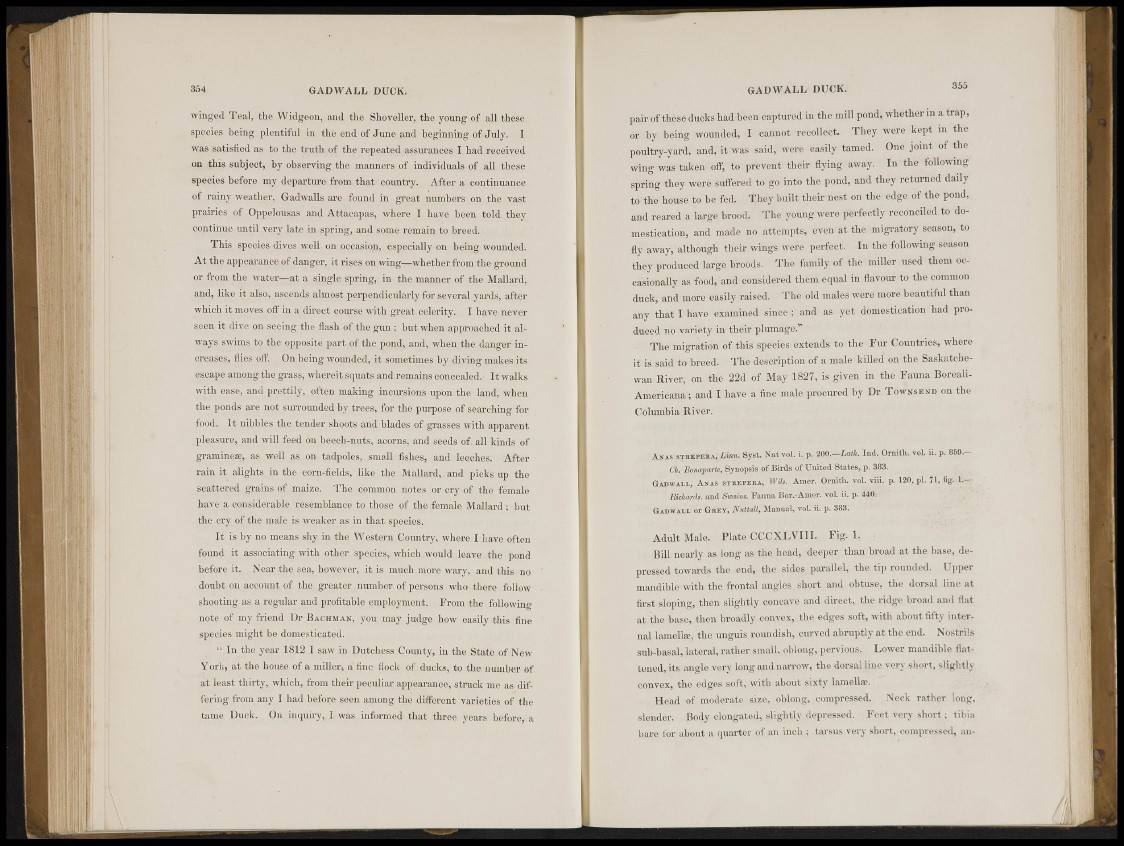
354 GAD W A L L DUCK.
•winged Teal, the Widgeon, and the Shoveller, the young of all these
species being plentiful in the end of June and beginning ofcluly. I
was satisfied as to the truth of the repeated asMtnuioes I had received
on this subject, by observing the manners of individuals of all these
species before my departure from that country. After a continuance
of rainy weather, (iad walls are found in great numbers on the vast
prairies of Oppelousas and Attacapas, where I have been told they "
continue until very late in spring, and some remain to breed.
This species dives well on occasion, especially on being Wounded.
At the appearance of danger, it rises on wing—whether from the. ground
or from the water—at a single-spring* in the manner of thé Mallard,
and, like it. also, ascends almost perpendicularly for several yards, after
which it moves off in a direct course with treat celerity. .. J. have never
seen it dive on seeing thé liash of the gun ; but when approached'it always
swims to the opposite part of the pond, and, when the danger increases.,
flies off. On being wounded, it;||me,tiflies by diving mates its
escape among the grass, whereit-.squats and remains concealed. It walks
with: ease, and prettily, ofteu making incursions upon the land, when
the ponds are not surrounded by trees, for the purpose of searching for
food. It nibbles the. tendgÉshoo.ts and blades of grasses with apparent
pleasure, and will feed on beech-nuts, acorns, and seeds of. all kinds of
gramme»;, as well as on tadpoles, small fishes, ami leeches. After
rain it alights in the corn-fields, like the Mallard, and picks up the
scattered grains of maize.. The common notes or cry ..f the female
have a considerable resemblance to those of the female Mallard ; hut.
the cry of the male is weaker as.in that species.1 ,
It is by-no means shy in the Western Country. wli.ofj; I have often
found it associating with othjïr species, which.would .leave the pond
before: it. Near the sea. however, w i s much more wary, and this no
doubiypp account, of the . greater number of persons who there follow
shooting a regular and profitable employment. From the following
note of my friend Dr Hachma.n, you may judge how easily this fine
species might be domesticated.
" In the year 1812 I saw in l)titvhess| County, in the State of New
York, at the house iij'a miller, à fine flock of duck>, to the number of
at least thirty, which, from their peculiar; appearance, struck me as differing
from, any I had bci'oçe seen among the different varieties of the
tame Duck. On inquiry, I was informed that three years before, a
GADWALL DUCK. 355
pair, of these ducks had been captured in the mill pond, whether in a trap,
or. by- being wounded, I cannot recollect. They were kept in the
poultry-yard, and, it was said, were easily tamed. One joint of the
Wing was taken Off, to prevent their flying away. In the following
spring they were suffered tofft into the pond, and they returned daily
to 'the house to be fed. They built their nest on the edge of the pond,
and reared a. large brood. The. young were perfectly reconciled to domestication,
and made no attempts, even, at the migratory season, to
ily away, although .fluir wings, Weie perfect,: In the following season
they produced large broods. The family of the miller used them occasionally
ais food, and: considered tli.-m equal in flavour to the common
duck, and more easily raised. The old males were more beautiful than
any that I have examined sinico ; and »«. yet domestication had produced
no variety in-tlieir plumage."
• The migration of this species extends to the Eur Countries, where
it is said to breed. The description of a male killed on the Saskatchewan
llivor, on the 22d of May 1827, is given in the Fauna Boreali-
Aiherieana ; and I have Á fine male procured by Dr TOWSSEND on the
Columbia River.
Asís »trípeua, /An, SY«T. NAT VOL1, I. P. 200.- Utk. IILD, ORMTH. VOL II. P. 85».-
Gh. Bonaparte, SVNOPSIS OF. BIRDS OF UNITED STATES, P. 383.
G»ii%vaix, Ana» sTKKrMA, FIFE. AMER. ORNIIH. VOL. VIII. P. 120, PI. 71, 4G. L.^I
MDWRDS. AND Swims. FINN* LIOR.-AMER. VOL II. P. 440.
Gadwali. OR ÜHV.Y, Xut'tU, MANUAL, VOL. II. P. 383.
Adult Male. Plato CCCXl.VIII. Fig- 1- •
Bill nearly as; long as the head, deeper than'broad at the base, depressed
towards the end, the sides parallel, the tip rounded. Upper
mandible with the frontal angles, short and obtuse, the dorsal line at
first sloping, then slightly concave and direct, the ridge broad and flat
at the base, then broadly convex, the edges soft, with about fifty internal
lamellae, the unguis roundish, curved abruptly at the end. Nostrils
sub-basal, lateral, rather small, oblong, pervious. Lower mandible flattened,
its angle very long and narrow, the dorsal line very short, slightly
convex, the edges soft, with about sixty lamellae.
Head of moderate size, oblong, compressed. Neck rather long,
slender. Body elongated, slightly depressed. Feet very short; tibia
bare for about a quarter of an inch; tarsus very short, compressed, an